The Apple iPad Pro Review
by Ryan Smith, Joshua Ho & Brandon Chester on January 22, 2016 8:10 AM ESTSystem Performance Cont'd
Continuing on with our more game-like benchmarks, tests like 3DMark and GFXBench are supposed to replicate gaming workloads to help determine relative performance in most common 3D games. In the case of the iPad Pro, the GPU is a 12 cluster variant of the PowerVR Series7XT GPU architecture. This is double the number of clusters relative to the A9’s GPU, which should prove to be quite impressive judging by the GPU performance that we saw in the iPhone 6s.
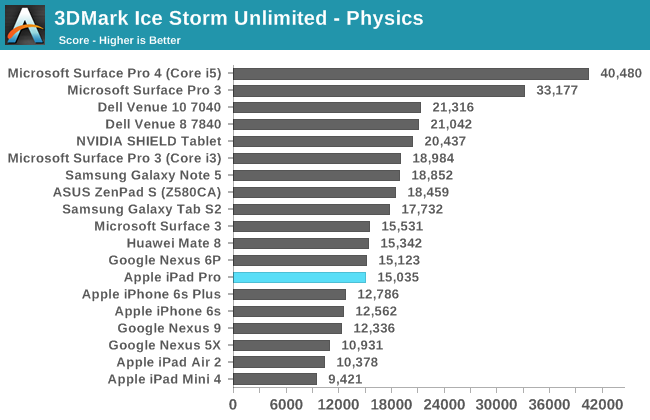
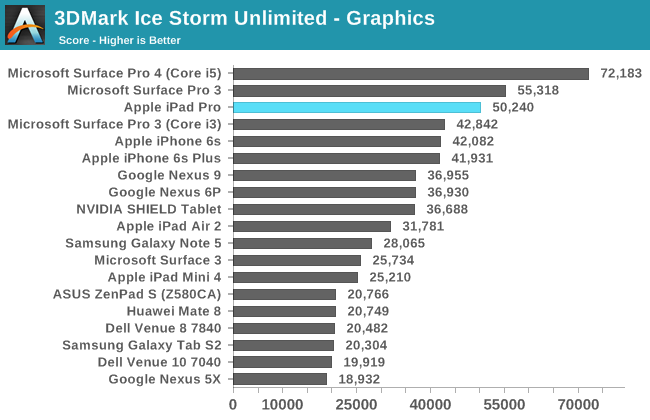
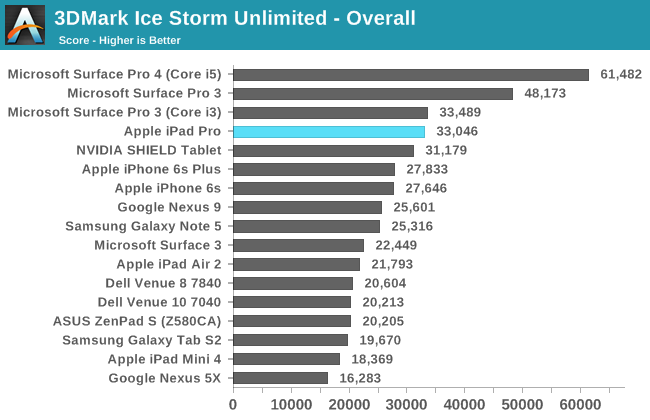
The iPad Pro manages to maintain superiority in 3DMark, but we're really starting to see the limitations of this test. The physics test generates non-sequential data structures with memory dependencies, which can penalize devices with lower core count and clock speed, but the workload is able to be spread across multiple cores to exploit TLP, which benefits devices with more real cores, or virtual ones (hyperthreading). We also see that the graphics test isn't really scaling well at this point as it's just too light to take advantage of the full potential of the A9X GPU. This likely also explains why the iPad Pro isn't closer to the Surface Pro 4 in performance on this benchmark, given what we know about A9X's GPU.
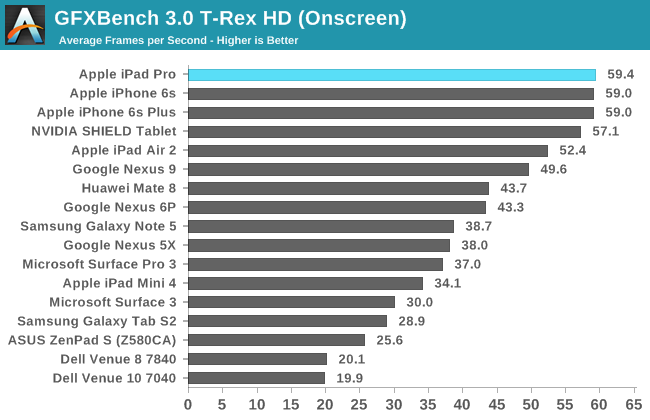
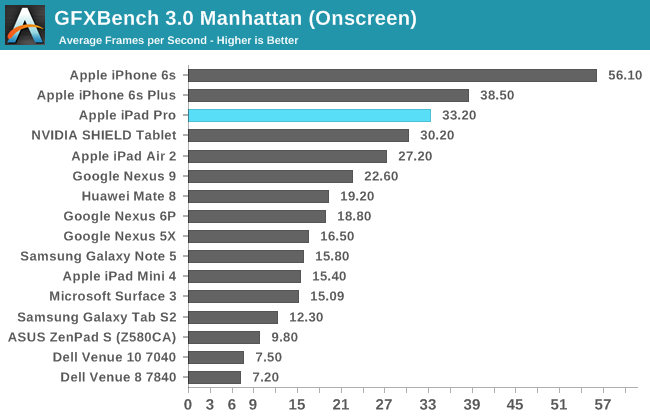

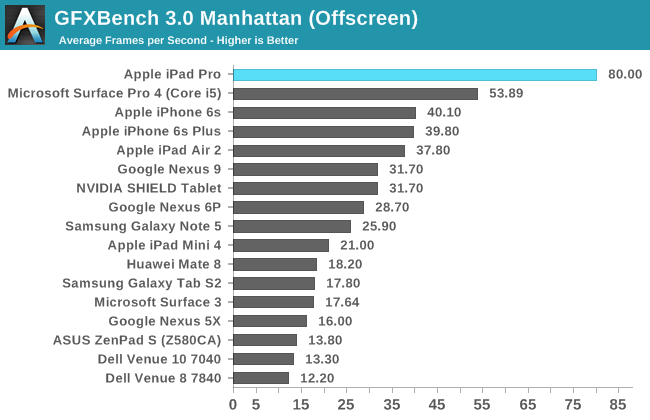
In GFXBench we can see the major benefits that really come with the larger GPU. It's pretty obvious here that clock speeds are basically identical when comparing the A9 GPU and A9X GPU as the scaling is almost perfectly double. In this benchmark the iPad Pro quite handily beats the Surface Pro 4, but it's important to keep in mind that the Surface Pro 4 is running a higher level of precision and that the iPad Pro is running OpenGL ES rather than OpenGL in this test, so it isn't strictly apples-to-apples (nor is such a thing truly possible at this time). Overall though the GPU of the iPad Pro is incredibly impressive, and I doubt that anyone will really have issues with gaming performance on this device.
NAND Performance
At this point it’s pretty well understood that storage performance can often be a gating factor in performance. Although caching is an amazingly effective method of hiding memory latency, for the first hit it’s mandatory to miss the cache unless you’ve managed to prefetch the data in question. The other issue where storage performance becomes obvious are cases where it’s necessary to commit data to storage first. Some cases where this is going to be obvious is app installation or iCloud restores, especially when network performance is at the point where installation can actually be gated by writing to disk rather than downloading from the network.
In the case of the iPad Pro, Apple claims that they’ve implemented a storage controller comparable to some desktop SSDs. It turns out that this controller is a familiar one, as the storage controller identifies itself as the APPLE SSD AP0128K in the case of this review unit. It turns out that everything about this SSD is identical to what we saw in the iPhone 6s as well, down the use of Hynix for at least one of the NAND vendors and the hybrid SLC/TLC architecture discussed in previous articles. In order to test how this storage solution performs we once again use Eric Patno’s StorageBench, which provides a rough analogue to AndroBench 3.6.
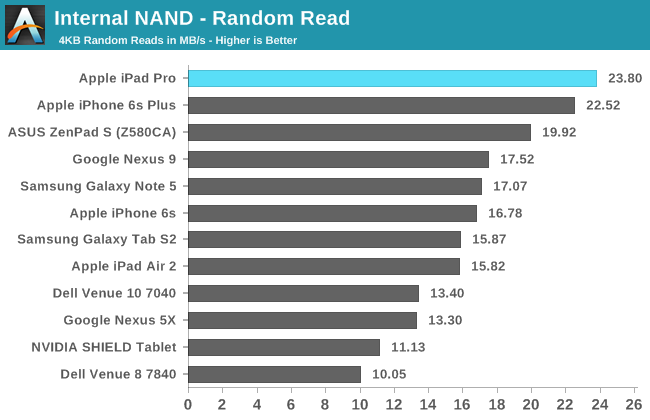

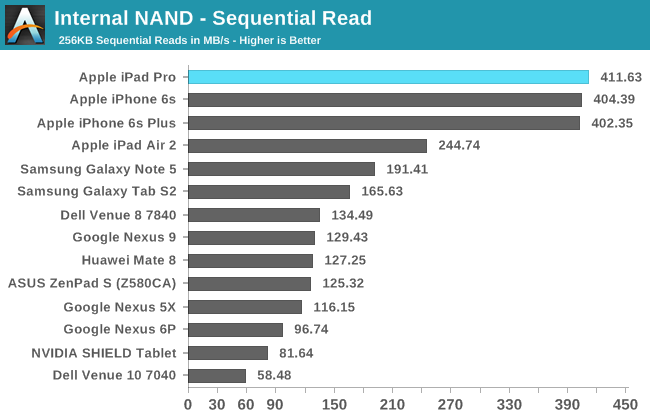
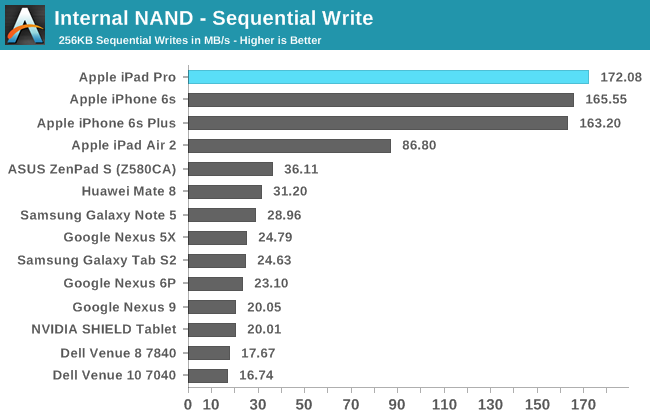
It turns out that in this test, performance is basically identical to the iPhone 6s. This isn’t quite the equal of something like the Surface Pro 4’s PM951 SSD, which has the advantage of more NAND dies working in parallel, but given that the iPad Pro PCB size isn’t going to be anywhere near that of the Surface Pro 4 it’s likely that this is a concession to gain better battery life. I definitely wonder what performance would be like relative to a Surface Pro 4 if the iPad Pro had a 512GB SKU, but given that the iPad Pro tops out at 128GB this isn’t really a question with a relevant answer.










408 Comments
View All Comments
lilmoe - Friday, January 22, 2016 - link
ok......Sc0rp - Friday, January 22, 2016 - link
Well, I have to disagree with you on one thing here. I don't think Apple has any blame here when it comes to software. iOS9 is faaaaaaaar more powerful and capable than Mac OS 8 and 9 that I used to run on my power PC's back in the late 90's. Those computers were certainly productive. There's nothing on a software level that's really stopping developers from making productive software for the iPad Pro or even the Air. There is an interface challenge, much as there was an interface challenge when GUI's first came out. As I recall, people lambasted GUI's and mouses as being toys and not for serious work back then. The endless whining over the iPad Pro is just a reverberation of that. People don't like change and they don't like things that rub against their doctrine. But, consider this... While many adults actually have some difficulty adapting to this new computing paradigm, youngsters adapt to it like a fish to water.I think it is a wild boast to call an iPad Pro a 'useless toy'. I certainly have made a ton of use of mine. Of course, I'm an artist so there's that. Not to mention that my iPads have been my primary communication hub for the last five years.
Jumangi - Friday, January 22, 2016 - link
iOS blows as an actual productivity system. It is made for smartphones first(Apple's cash cow) and everything else second. Put a version of Mac OSX on this and you have something. Right now this is an expensive artists toy.strangis - Friday, January 22, 2016 - link
> While many adults actually have some difficulty adapting to this new computing paradigm, youngsters adapt to it like a fish to water.That's why I, as someone of the Commodore Vic 20 era, has to show relatives and clients 25 years younger than me how to use their phones, tablets and computers every week. Regardless of age, some people get it, some don't.
Similarly, I've never seen the value of an iPad Pro when, as an artist), I need to finish in Photoshop or After Effects. The creative tools available on the iPad Pro are limiting for those of us used to more, and considering its price, better to buy something that will get the job done.
Murloc - Saturday, January 23, 2016 - link
I have no doubt people will only use tablets once they'll be able to interact with the interface with their brains.Relic74 - Saturday, February 27, 2016 - link
Yea but at least Mac OS had a proper file-system, allowed it's users to select their own default apps, appsdidn't require API's in order to talk to the system, all applications used the same resolution, when a new feature was added to the system every app was able to utilize it immediately and didn't require it's developer to update their apps, the user was ablue to customize their desktop and even the UI, supported widgets, applications were windowed and ran desktop software. Actually, I take it back, Mac OS's UI was a lot more powerful, the system not so much, which is reversed in iOS, the UI isn't very powerful, it's actually pretty vanilla, though it's BSD underpinnings are extremely powerful. If I was able to access the BSD system, I would dump iOS's UI in a heart beat and install a X desktop environment like Gnome 3, which actually works fairly well as a tablet OS. Than maybe the iPad Pro would actually be a Pro device. I'm running Arch Linux on a Xiaomi MiPad 2, love it.NEDM64 - Friday, January 22, 2016 - link
Dude!If you were in the 80's, you'll be advocating text user interfaces instead of graphical user interfaces.
If you were in the 70's, you'll be advocating separate terminals connected to computers, as opposed to "all-in-ones" or "intelligent terminals" like the Apple II, Commodore PET, TRS-80.
Opinions like yours, with due respect, don't matter, because people like you, already have their rigs in place, and aren't in the market.
Apple's market position is for people that want the next thing, not the same ol' thing…
RafaelHerschel - Saturday, January 23, 2016 - link
Apparently the next thing is a larger iPad. I'm going to be bold and predict the next next thing. It's going to be a slightly thinner version of the larger iPad. Awesome.Murloc - Saturday, January 23, 2016 - link
you aren't understanding tilmoe's posts.You can spend millions developing software for a superpowerful tablet.
You will still never be able to fit Photoshop's whole interface and abundance of options and menus into the tablet in a way that the user is easily able to reach them, without scrolling through pages of big buttons.
At the end of the day, you'll get a crippled version of photoshop and the user will have to get on a traditional computer (a WORKstation, not because it's more powerful, not because software houses invest more in it, but because it has human interaction devices and a big screen that enable humans to get work done faster) to get stuff done.
Tablets are mostly content consumption products exactly because of the limited interfaces. They have the advantage of portability and ease of use, you just open apps while on the couch, and that's why they master content consumptions better than say laptops.
Constructor - Saturday, January 23, 2016 - link
It's by now become a quasi-religious belief system for some that "mobile devices cannot ever be used for any professional purposes whatsoever!".At the same time more and more people (and businesses!) don't care about such beliefs in the slightest and simple use those devices very much professionally and in many cases with more success and higher productivity than they'd had with conventional computers.
Part of the reason is that agility and flexibility often beats feature count, all the more so since professional workflows very often just can't afford to even consider most of the myriad theoretical options some desktop programs offer. Heck, most professional uses actually don't need much more than a browser interface anyway!
Yes, there are some uses for which desktop or mainframe computers will be the only really viable option. But what you and many others didn't seem to have noticed is that those domains have been shrinking rapidly over the last decade(s).